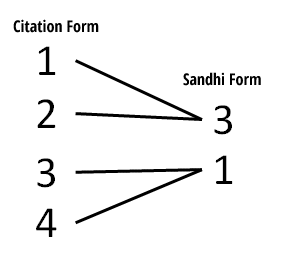Penang Hokkien is a language where the syllables change their tone based on their location within a sentence. This is known as tone sandhi. When the word undergoes a tone change, we say that it "sandhis".
If you are learning Penang Hokkien, please go through the introduction to tone sandhi on this page, then continue by reading Tone Sandhi Pointers, which is written specially to help learners acquire a skill that native speakers often take for granted.
1.0: Morphemes
Morphemes are a grammatical unit that carries a meaning. They can function independently as words (e.g. bird, break) or appear as parts of words (un-, -ing, -tion). In English, we can form words by putting the morphemes together (bird+cage, friend+ly, un+break+able).In Penang Hokkien, a syllable that carries a meaning is a morpheme. For example, ang2 (red) is both a morpheme and a word; ang3mor2 (Westerner) are two morphemes (ang2 = red and mor2 = hair) but are placed together to form a single word (a compound noun).
Free morpheme can stand on its own as a word, for example ang2 (red).
Bound morpheme has to attach to other morpheme(s) to form a word, for example tan1 in ang3mor3tan1.
All morphemes are syllables, but not all syllables are morpheme. A word may comprise one morpheme (ang2) or several morphemes (ang3mor2, ang3mor3 tau3iu2).
Different morphemes in Penang Hokkien can also be put together to form words or compound nouns. For example, the morphemes too1 (pig) and bak3 (meat) can be joined to form the compound noun too3bak3 (pork). Notice however that the morpheme too1 has changed to too3 in the word too3bak3. This tranformation is known as tone sandhi.
1.1: Tone Sandhi in Penang Hokkien
We learned in the chapter on Intonation that there are four tones, 1, 2, 3 and 4.The rules of tone sandhi is pretty simple:
morphemes of tones 1 and 2 change to tone 3;
morphemes of tones 3 and 4 change to tone 1.

I also devised a simple rule to make it easy to remember:
1 + 2 = 3
4 - 3 = 1
In accordance to this rule, the morpheme kiam2 (salty) becomes kiam3 when placed in front of pneah4 (biscuit) to form kiam3pneah4 (salty biscuit).A word like kiam2, as listed in the dictionary, is said to be in the citation tone. That's the original tone before it undergoes sandhi. When it sandhis, kiam2 becomes kiam3 as in the compound noun kiam3pneah4.
However, the compound noun kiam3pneah4 (salty biscuit) may also be listed in the dictionary and is regarded to be in the citation tone too, because it also can sandhi its final morpheme when creating another compound noun, as in kiam3pneah1tin1 (salty biscuit tin).
Morphemes that don't sandhi
A group of tone-3 morphemes do not sandhi. To differentiate them from those that do, these morphemes are assigned the numeral 33. Among the common tone-33 morphemes are bin33 (face), gor33 (five), lang33 (to taunt), lau33 (old), tang33 (dark) and tua33 (big)Lau33 (old) remains lau33 in lau33lang2 (old man). Similarly, the morpheme gor33 (five) remains gor33 in gor33-cap1 (fifty).
To help identify the tone 3 morpheme that do not sandhi, I mark them with tone 33 in the dictionary.
2.0: Examples
gor33-cap3-gor33
fifty-five
chit1-cap3-chit3

seventy-seven The word gor33 (five) does not change its tone regardless its location within a disyllabic or polysyllabic word. In comparison, the word chit3 (seven) changes its tone to chit1 when it is in front of another syllable.
3: Rules of Tone Sandhi
The rules of Tone Sandhi is quite complex and is mentioned here, as well as in other related chapters.Morphemes sandhi under various circumstances, depending on whether it is a noun, pronoun, verb, adjective, particles, etc.
3.1: Nouns Nouns sandhi when it modifies another noun, or when forming a compound noun.
ong2
 - king
- kingong3boh3
 - crown
- crownbak3
 - meat
- meatbak1chang3
 - meat dumpling
- meat dumplingkam1
 - orange
- orangekam3chooi4
 - orange juice
- orange juicekao4
 - dog
- dogkao1knia4
 puppy
puppyknia4
 - child, offspring
- child, offspringknia1soon1
 - descendant
- descendantpo3piah4
 - wet springroll
- wet springrollpo3piah1 cni3
 - deep-fried springroll
- deep-fried springroll3.2: Pronouns
Wah4 and lu4 are in the citation tone when they serve as object.
Wah1 kio33 lu4.

I call you.
Lu1 kio33 wah4.

You call me.
Wah4 and lu4 are in citation tone in the presence of an object complement. In the example below, the object complements are italicized.
Lu1 kio33 wah4 Ah3 Hock3.

You call me Ah Hock.
Lu1 kio33 wah4 mm33 tiok3 mia2.
 You call me by the wrong name.
You call me by the wrong name.Wah4 and lu4 sandhi when they act as subject.
Wah1 ciak1.

I eat.
Lu1 ciak3 pnui3.

You eat rice.
Wah4 and lu4 reverts to the citation tone in emphatic sentences.
Wah4 ciak1, lu4 mm33thang3 ciak1!

I eat, you don't eat!
A3si33 wah4 kio33 lu4, lu4 lai2.

It I call you, you come.
The other pronouns (i1, ee1, lan4, wah1lang2, lu1lang2, ie1lang2, ee1lang2 and lan1lang2) do not sandhi. They stay the same as subject or object.
3.3: Verbs
Verbs are in citation tone when they are the final word in a sentence.
Ie1 uh33 beh4.

He did buy.
Verbs sandhi when they take an object.
Ie1 beh1 chaek3.

He bought books.
Verbs are not affected by the presence of particles at the end of sentences. In other words, even when a particle is the final word in a sentence, and the verb is in second last position, it is still in citation form.
Ie1 uh33 beh4 boh2?

He did buy, didn't he?
Ie1 beh1 chaek3 nia2?

He bought books, didn't he?
Verbs sandhi even when they are separated from the object by verb suffixes such as tiok3, boh3 and uh3.
Ie1 beh1 tiok3 chaek3.

He bought up the books.
Ie1 beh1 boh3 chaek3.

He bought no books.
Ie1 beh1 uh3 chaek3.

He had the chance to buy the books.
Verbs are in the citation form if it is separating from the object (by an article, demonstrative or possessive).
Example 1: beh4 = to buy
Ie1 beh1 kao4.

He buys dog.
but
Ie1 beh4 cit3-ciak1 kao4.

He buys a dog.
Ie1 beh4 heh1-ciak1 kao4.

He buys that dog.
Ie1 beh4 wah1-eh3 kao4.

He buys my dog.
3.4: Adjectives Adjectives remain in the citation tone when they are the final word in a sentence.
Ie1-eh3 bin3 ang2.

His face is red.
but
Ie1 thau3bi1 ie1-eh3 ang3 bin3.

He hid his red face.
Ie1-eh3 chaek3 sin1.

His book is new.
but
Ie1 thark1 ie1-eh3 sin3 chaek3.

He read his new book.
Adjectives take on the Modified Form when they precede the noun they modify.
Ie1-eh3 ang3 bin3.

His red face.
Ie1-eh3 sin3 chaek3.

His new books.
3.5: Classifier Classifiers behave in the same way as adjectives. They remain in the Basic Form when they are the final word in a sentence, but change to the Modified Form when they precede the nouns they attribute. This is true when the classifier is part of a demonstrative adjective (i.e. this, that). Note that the verb in such instances can also take on the Basic Form.
Ie1 beh1 cit3-pun1 chaek3.

He bought a book.
Ie1 beh4 cit3-pun4.

He bought one.
Lu1 uh33 kui1-ciak1 kao4?

How many dogs do you have?
Wah1 uh33 cit3-ciak3.

I have one.
Wah1 beh4 cit1-keng3 chu3.

I bought this house.
Wah1 beh4 cit1-keng1.

I bought this (one).
3.6: Particles Most particles appear at the end of sentences and clauses, where they have no chance to sandhi. At the end of sentences, particles also do not cause the word before them to sandhi.
Ee1 ciak3 pnui3.

She eats rice.
Ee1 ciak3 pnui3 nia2?

She eats rice, doesn't she?
In the above set of sentences, note that the word pnui3 does not sandhi even when a particle is added behind it.
Particles serve as negators and affirmators when inserted within sentences. In such positions they do sandhi.
Lu1 uh33 ciak3 pnui3 boh2?

You do eat rice, don't you?
Wah1 boh3 ciak3 pnui3.

I don't eat rice.
The possessive particle -eh2 is located at the end of sentences to form possessive nouns and pronouns, but sandhis to -eh3 to form possessive adjectives.
Cit1-teng1 chia1 si33 wah1-eh2.

This car is mine.
Cit1-teng4 si33 wah1-eh3 chia1.

This is my car.
3.7: Prepositions The prepositions ti1, ka3 and hor33 do not change their tone.
Lu1-eh3 chaek3 tua3 ti1 tok1teng4.

Your book is on the table.
Wah1 ka3 lu1 kong4.

I tell you. (literally, "I with you say")
Wah1 ka3 ie1 khee1 khnua1 hee3.

I went to see a show with him.
Ie1 hor33 wah1 mae3.

He got scolded by me.
Wah1 co3 hor33 ie1.

I do it for him.
Language Learning Tools
Use the following language learning tools to learn Penang Hokkien!Learn Penang Hokkien with uTalk
This app opens the door to over 150 languages.Return to Penang Hokkien Resources

Copyright © 2003-2025 Timothy Tye. All Rights Reserved.

 Go Back
Go Back
